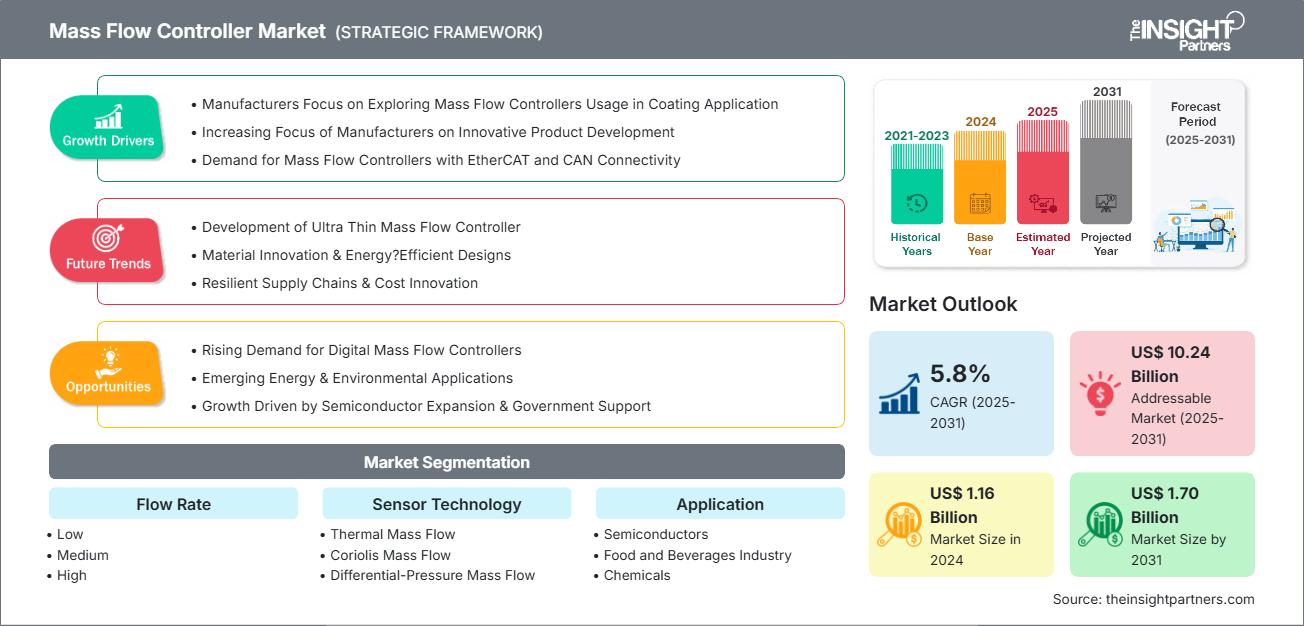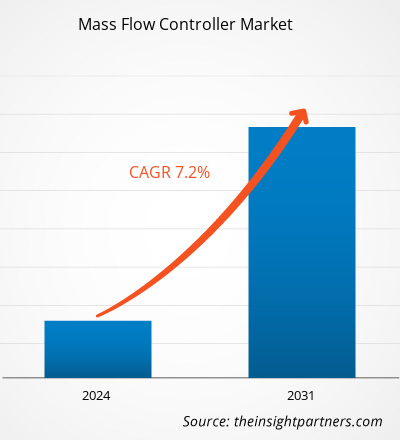질량 유량 제어기 시장 규모는 2024년 11억 6천만 달러에서 2031년 17억 달러로 성장할 것으로 예상됩니다. 이 시장은 2025년부터 2031년까지 연평균 성장률 5.8%를 기록할 것으로 예상됩니다.
질량 유량 컨트롤러 시장 분석
질량 유량 제어기는 질량 유량을 모니터링하고 미리 정해진 유량으로 자동 조절하는 유량 제어 장치입니다. 유체는 질량 유량(중량)과 체적 유량, 두 가지 방법으로 측정할 수 있습니다. 질량 유량 제어기는 온도와 압력 변화에도 불구하고 질량 유량을 정밀하게 모니터링하고 제어할 수 있습니다. 따라서 질량 유량 제어기는 반도체 제조 공정, 분석 장비 등 뛰어난 반복성과 정확성이 요구되는 분야에 널리 사용됩니다. 열 센서와 코리올리 센서는 질량 유량 모니터링에 가장 일반적으로 사용됩니다. 열 센서는 유체 흐름에 따른 온도 변화를 감지하여 질량 유량을 모니터링합니다. 코리올리 센서는 유체 진동으로 발생하는 코리올리 힘을 감지하여 질량 유량을 계산합니다. 이 방법은 유체(기체 또는 액체)와 사용 조건에 따라 선택해야 합니다. 반도체, 석유 및 가스, 화학, 제약 및 의료, 식음료 등의 산업에서는 다양한 공정 환경에서 안정적인 유량을 측정, 제어 및 유지하기 위해 질량 유량 제어기를 적극적으로 도입하고 있습니다.
질량 유량 컨트롤러 시장 개요
산업 확장, 코팅 분야에서 질량 유량 컨트롤러(MFC) 사용을 모색하기 위한 연구 개발 활동 증가, 그리고 제조업체의 제품 개발에 대한 집중도 증가는 질량 유량 컨트롤러 수요를 견인하는 주요 요인입니다. EtherCAT 및 CAN 연결을 갖춘 질량 유량 컨트롤러에 대한 수요 증가와 산업 전반의 정밀성 요구 증가는 시장 성장을 촉진하고 있습니다. 기술 발전, 디지털 질량 유량 컨트롤러에 대한 수요 증가, 그리고 제조업체의 맞춤형 질량 유량 컨트롤러 개발에 대한 집중은 예측 기간 동안 시장에서 수익성 있는 기회를 창출할 것으로 예상됩니다. 또한, 소형 제품에 대한 산업 수요, 초박형 질량 유량 컨트롤러 개발, 그리고 차세대 질량 유량 컨트롤러의 발전은 시장의 미래 성장 기회를 창출할 것으로 예상됩니다.
이 보고서의 일부 또는 국가 수준 분석, Excel 데이터 팩을 포함하여 모든 보고서에 대한 사용자 정의를 무료로 받을 수 있으며, 신생 기업 및 대학을 위한 훌륭한 혜택과 할인도 이용할 수 있습니다.
질량 유량 컨트롤러 시장: 전략적 통찰력

-
이 보고서에서 주요 시장 동향을 알아보세요.이 무료 샘플에는 시장 동향부터 추정치 및 예측까지 다양한 데이터 분석이 포함됩니다.
질량 유량 컨트롤러 시장 동인 및 기회
시장 동인:
-
코팅 응용 분야에서 질량 유량 제어기 사용에 대한 제조업체의 초점
질량 유량 컨트롤러는 반도체 생산 및 테스트에서 정확한 가스 유량 제어를 위해 널리 사용됩니다. -
EtherCAT 및 CAN 연결을 갖춘 질량 유량 컨트롤러에 대한 수요EtherCAT and CAN Connectivity
질량 유량 컨트롤러는 반도체 제조, 버너 및 기타 응용 분야에서 정확한 가스 유량 제어에 필수적입니다. -
제조업체의 혁신적 제품 개발에 대한 관심 증가
질량 유량 컨트롤러(MFC)는 다양한 산업 분야에서 유체 흐름을 정밀하게 제어하는 데 중요한 역할을 합니다. -
성장하는 반도체 산업
칩 생산이 증가함에 따라 정밀한 가스 흐름 제어에 대한 수요도 증가하고 있습니다.
시장 기회:
-
디지털 질량 유량 컨트롤러에 대한 수요 증가
산업계에서는 현대의 산업 자동화 요구 사항을 충족하는 데 있어 정밀성, 신뢰성, 유연성을 갖춘 디지털 질량 유량 컨트롤러를 요구합니다. -
IoT 및 스마트 센서와의 통합
스마트 MFC는 원격 모니터링과 예측적 유지관리 기능을 제공합니다. -
의료 및 생명공학 응용 분야의 채택
MFC는 진단 및 약물 생산 시 가스 흐름 제어에 사용됩니다. -
MFC의 사용자 정의 및 소형화
특정 산업에 대한 맞춤형 솔루션은 틈새 시장의 기회를 창출합니다.
질량 유량 컨트롤러 시장 보고서 세분화 분석
질량 유량 제어기 시장은 작동 방식, 성장 잠재력, 그리고 최신 동향을 더욱 명확하게 보여주기 위해 여러 부문으로 구분됩니다. 대부분의 업계 보고서에서 사용되는 표준 세분화 방식은 다음과 같습니다.
제공을 통해:
-
낮은
질량 유량 컨트롤러에서 낮은 유량 속도는 일반적으로 분당 밀리리터 이하의 범위 내에서 소량의 가스나 액체를 정밀하게 조절하는 것을 의미합니다. -
중간
질량 유량 컨트롤러로 관리되는 중간 유량 속도는 일반적으로 적당한 범위를 포괄하며, 종종 분당 몇 표준 세제곱센티미터(sccm)에서 분당 수 리터에 이릅니다. -
높은
이러한 질량 유량 컨트롤러는 종종 분당 수십 또는 수백 리터에 달하는 대량의 가스나 액체를 처리할 수 있으므로 높은 유량 속도를 제어합니다.
센서 기술을 통해:
-
코리올리 질량 유량
코리올리 질량 유량 센서는 유체가 튜브를 통과할 때 진동하는 튜브의 처짐을 측정하여 질량 유량을 직접 측정합니다. 이러한 처짐은 코리올리 효과에 의한 것입니다. -
열 질량 흐름
열 질량 유량 센서는 가열된 요소 위를 흐르는 가스나 액체에 의해 발생하는 열을 측정하여 질량 유량을 결정합니다. -
차압 질량 유량
차압(DP) 질량 유량 센서는 기존 장애물의 압력 강하를 이용하여 유량을 결정하는데, 이는 질량 유량 계산을 위해 온도 및 압력 조정과 결합되는 경우가 많습니다.
응용 프로그램별:
- 반도체
- 식품 및 음료 산업
- 약
- 제약 및 의료 산업
- 석유 및 가스
- 기타
지리별:
- 북아메리카
- 유럽
- 아시아 태평양
- 라틴 아메리카
- 중동 및 아프리카
아시아 태평양 지역의 대량 유량 제어기 시장은 급속한 산업화, 제조 부문의 확대, 중국과 인도 등 신흥 경제권에서의 자동화 도입 증가로 인해 가장 빠른 성장을 보일 것으로 예상됩니다.
질량 유량 제어기 시장 지역별 통찰력
The Insight Partners의 분석가들은 예측 기간 동안 질량 유량 제어기 시장에 영향을 미치는 지역별 동향과 요인을 면밀히 분석했습니다. 이 섹션에서는 북미, 유럽, 아시아 태평양, 중동 및 아프리카, 중남미 지역의 질량 유량 제어기 시장 부문 및 지역별 분포도 살펴봅니다.
질량 유량 컨트롤러 시장 보고서 범위
| 보고서 속성 | 세부 |
|---|---|
| 2024년 시장 규모 | 11억 6천만 달러 |
| 2031년까지 시장 규모 | 17억 달러 |
| 글로벌 CAGR(2025~2031년) | 5.8% |
| 역사적 데이터 | 2021-2023 |
| 예측 기간 | 2025-2031 |
| 다루는 세그먼트 |
유량별
|
| 포함된 지역 및 국가 |
북아메리카
|
| 시장 선도 기업 및 주요 회사 프로필 |
|
질량 유량 컨트롤러 시장 참여자 밀도: 비즈니스 역학에 미치는 영향 이해
질량 유량 제어기 시장은 소비자 선호도 변화, 기술 발전, 그리고 제품 이점에 대한 인식 제고 등의 요인으로 인한 최종 사용자 수요 증가에 힘입어 빠르게 성장하고 있습니다. 수요가 증가함에 따라 기업들은 제품 및 서비스 확장, 소비자 니즈 충족을 위한 혁신, 그리고 새로운 트렌드를 적극 활용하고 있으며, 이는 시장 성장을 더욱 가속화하고 있습니다.

- 질량 유량 제어기 시장 주요 주요 업체 개요를 확인하세요
지역별 질량 유량 컨트롤러 시장 점유율 분석
아시아 태평양 시장은 향후 몇 년 동안 가장 빠르게 성장할 것으로 예상됩니다. 중남미와 중동 및 아프리카의 신흥 시장 또한 질량 유량 제어기 공급업체에게 확장할 수 있는 많은 미개척 기회를 제공합니다.
질량 유량 제어기 시장은 지역마다 성장세가 다릅니다. 석유 및 가스, 화학, 광업 등의 산업 성장과 자동화 증가는 정밀 유량 제어 솔루션에 대한 수요를 견인하고 있습니다. 아래는 지역별 시장 점유율 및 동향을 요약한 것입니다.
1. 북미
-
시장 점유율:
글로벌 시장의 상당 부분을 차지합니다 -
주요 동인:
- 첨단 반도체 연구 개발 및 제조
- 강력한 생명공학 및 제약 부문
- 산업 전반에 걸친 Industry 4.0 기술 도입
-
트렌드:
MFC와 AI, IoT 및 클라우드 기반 분석의 통합
2. 유럽
-
시장 점유율:
기존 산업 자동화 및 제약 부문의 존재로 인해 상당한 점유율 -
주요 동인:
- 배출 모니터링을 촉진하는 엄격한 환경 규정
- 수소, 태양광 등 친환경 에너지 기술에 대한 투자
-
트렌드:
고도로 맞춤화된 소형화된 MFC에 대한 수요
3. 아시아 태평양
-
시장 점유율:
매년 시장 점유율이 증가하는 가장 빠르게 성장하는 지역 -
주요 동인:
- 급속한 반도체 제조 확장(특히 중국, 한국, 대만)
- 전자, 화학 처리 및 제약 부문의 강력한 성장
- 정부의 산업 자동화 및 스마트 공장 추진
-
트렌드:
수입 의존도 감소를 위한 국내 생산 및 연구개발 이니셔티브
4. 남미 및 중미
-
시장 점유율:
꾸준한 성장으로 성장하는 시장 -
주요 동인:
- 석유 및 가스, 화학, 광업 산업 확장
- 산업 자동화 및 안전 규정 준수로의 점진적인 전환
-
트렌드:
환경 모니터링 및 가스 분석 분야에서 MFC 채택 증가
5. 중동 및 아프리카
-
시장 점유율:
작지만 빠르게 성장하고 있습니다 -
주요 동인:
- 대규모 석유화학 및 석유·가스 인프라 프로젝트
- 청정 에너지(예: 수소, 태양광)에 대한 관심 증가
-
트렌드:
수처리 및 가스 분배 시스템에서 MFC 사용
질량 유량 컨트롤러 시장 참여자 밀도: 비즈니스 역학에 미치는 영향 이해
높은 시장 밀도와 경쟁
Horiba Ltd, Sensirion Holding AG, Teledyne Technologies Inc.와 같은 기존 업체가 있어 경쟁이 치열합니다. Dwyer Instruments, Inc., Avantor Inc, MKS Instruments Inc와 같은 지역 및 틈새 시장 공급업체도 여러 지역에서 경쟁 환경을 더욱 심화시키고 있습니다.
이러한 높은 수준의 경쟁으로 인해 기업은 다음과 같은 서비스를 제공하여 두각을 나타내야 합니다.
- 고급 진단 기능을 갖춘 스마트 MFC
- 일반 산업용 열 MFC
- 디지털, 고정밀 MFC
- 소형 시스템을 위한 소형화된 MFC
기회와 전략적 움직임
- MFC는 진단 및 약물 생산 시 가스 흐름 제어에 사용됩니다.
- 특정 산업에 대한 맞춤형 솔루션은 틈새 시장의 기회를 창출합니다.
- 수소 사용이 증가함에 따라 정확한 가스 흐름 제어에 대한 필요성이 커지고 있습니다.
질량 유량 제어기 시장에서 운영되는 주요 회사는 다음과 같습니다.
- 호리바 주식회사
- 센시리온 홀딩 AG
- 텔레다인 테크놀로지스 주식회사
- 브룩스 악기
- 파커 해니핀 코퍼레이션
- 아즈빌 주식회사
- 악세트리스 AG
- 드와이어 인스트루먼트 주식회사
- 아반토르 주식회사
- MKS 인스트루먼트 주식회사
면책 조항: 위에 나열된 회사는 특정 순서에 따라 순위가 매겨지지 않았습니다.
연구 과정에서 분석된 다른 회사:
- 브롱호스트 하이테크 BV
- 시에라 인스트루먼트
- 올보르그 인스트루먼트
- 후지킨 주식회사
- 아즈빌 주식회사
- 센시리온 AG
- 버커트 유체 제어 시스템
- 히타치 금속
- 오메가 엔지니어링
- 포에틀린 인스트루먼트 GmbH
- 알리캣 사이언티픽
- DKK-TOA 주식회사
- 린자이스 메세게라에테 GmbH
- 코플록
- 크로네 그룹
질량 유량 컨트롤러 시장 뉴스 및 최근 개발
-
HORIBA 그룹의 말레이시아 자회사인 Horiba Malaysia Sdn Bhd가 페낭주에서 새로 설립된 생산 기지로 이전할 예정입니다.
HORIBA 그룹의 보도자료에 따르면, HORIBA 그룹의 말레이시아 자회사인 Horiba Malaysia Sdn Bhd는 페낭주에서 이웃 케다주에 새로 설립된 생산 기지로 이전하여 2026년 1월에 본격 운영을 시작할 예정입니다. -
Sensirion Holding AG는 산업, 의료 및 분석 응용 분야에서 높은 정확도, 장기 안정성 및 다용성을 위해 설계된 SFC5300, SFC5400 및 SFC5500 질량 유량 컨트롤러를 제공합니다.
2022년 6월, 센시리온 홀딩 AG(Sensirion Holding AG)는 SFC5300, SFC5400, SFC5500 질량 유량 컨트롤러를 출시했습니다. 이 컨트롤러는 산업, 의료 및 분석 분야에서 높은 정확도, 장기 안정성, 그리고 다양한 기능을 제공하도록 설계되었습니다. 센시리온의 독자적인 CMOSens MEMS 기술을 활용하여 다중 가스 교정, 넓은 동적 측정 범위, 그리고 디지털 인터페이스와 같은 기능을 제공합니다. 특히 SFC5500 시리즈는 표준 기성품으로 제공되어 다양한 분야에 적용 가능하다는 점이 특징입니다. -
실험실 계측 장비의 유통, 서비스 및 제조를 전문으로 하는 벨기에에 본사를 둔 선도적인 국제 기술 그룹인 Aptco Group이 과학 장비 유통업체인 Schaefer-Tec을 인수했습니다.
2023년 11월, 벨기에에 본사를 둔 실험실 계측기 유통, 서비스 및 제조를 전문으로 하는 세계적인 기술 그룹인 Aptco Group이 과학 기기 유통업체 Schaefer-Tec을 인수했습니다. Schaefer-Tec은 Schaefer-Tec이라는 이름으로 계속 운영될 예정입니다. 독일, 프랑스, 스위스, 루마니아에 지사를 두고 있는 Schaefer-Tec은 거의 60년 동안 유럽 대륙 대부분 지역에서 Teledyne Hastings Instruments의 진공 게이지, 질량 유량계, 질량 유량 컨트롤러를 공급해 왔으며, 앞으로도 이러한 협력 관계를 유지할 것입니다.
질량 유량 컨트롤러 시장 보고서 범위 및 제공물
"대량 유량 제어기 시장 규모 및 예측(2021~2031)" 보고서는 아래 영역을 포괄하여 시장에 대한 자세한 분석을 제공합니다.
- 범위에 포함된 모든 주요 시장 부문에 대한 글로벌, 지역 및 국가 수준의 질량 유량 컨트롤러 시장 규모 및 예측
- 질량 유량 제어기 시장 동향 및 드라이버, 제약 및 주요 기회와 같은 시장 역학
- 자세한 PEST 및 SWOT 분석
- 주요 시장 동향, 글로벌 및 지역 프레임워크, 주요 참여자, 규정 및 최근 시장 개발을 포괄하는 질량 유량 컨트롤러 시장 분석
- 시장 집중도, 히트맵 분석, 주요 업체 및 대량 유량 제어기 시장의 최근 개발 사항을 다루는 산업 환경 및 경쟁 분석
- 자세한 회사 프로필
- 과거 분석(2년), 기준 연도, CAGR을 포함한 예측(7년)
- PEST 및 SWOT 분석
- 시장 규모 가치/거래량 - 글로벌, 지역, 국가
- 산업 및 경쟁 환경
- Excel 데이터세트
최근 보고서
관련 보고서
사용 후기
구매 이유
- 정보에 기반한 의사 결정
- 시장 역학 이해
- 경쟁 분석
- 고객 인사이트
- 시장 예측
- 위험 완화
- 전략 기획
- 투자 타당성 분석
- 신흥 시장 파악
- 마케팅 전략 강화
- 운영 효율성 향상
- 규제 동향에 발맞춰 대응






















 무료 샘플 받기 - 질량 유량 제어기 시장
무료 샘플 받기 - 질량 유량 제어기 시장